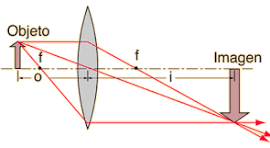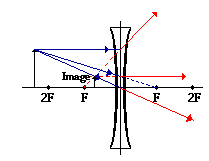ap physics 2 things i forget
1/15
Earn XP
Description and Tags
Name | Mastery | Learn | Test | Matching | Spaced |
|---|
No study sessions yet.
16 Terms
what type of lens forms real images
converging lens
(si positive, image is real)
what type of mirror forms real images
concave mirror
(si is positive, image is real)
what side of the mirror do real images form
on the same side as the object
what side of the mirror do virtual images form
the opposite side of the object
virtual images are always ___
virtual images are always upright and located behind the mirror
(positive M value) (negative si value)
real images are always ___
real images are alwasys inverted and located in front of the mirror 'cone
convex mirrors can only form ___ images, because ____
convex mirrors can only form virtual images, because f is negative and so is positive- the onyl way to satisfy the euqation is for si to then be negative. ( thus image is located on opposite side of mirror).
diverging lenses create ___ images
diverging lenses create virtual images
converging lenses are also called ___ lenses, because?
converging lenses are also called convex lenses because f is positive
however! converging lenses still always make real images. can
diverging lenses are also called ___ lenses, because?
diverging lenses are also called concave lenses because f is negative
however! diverging lenses still always make virtual images.
can a neutral conducting object be attracted to a positively charged particle?
yes
ray diagram for convex lense

ray diagram for concave lens

at what time will the current going through a resistor parallel to a capacitor be greatest?
the current through the resistor will be greatest a logn time after closing the switch.
what is the difference between electric and gravitational fields?
Electric fields are caused by electric charges, while gravitational fields are caused by mass.
Electric fields attract or repel charges, while gravitational fields attract masses.
the relationship between the density of a gas and its temperature
As the temperature of a gas increases, its density decreases.
Explanation:
When the temperature of a gas increases, the gas molecules gain kinetic energy and move faster, spreading out more. This results in a decrease in density because the same amount of gas now occupies a larger volume due to increased molecular motion.